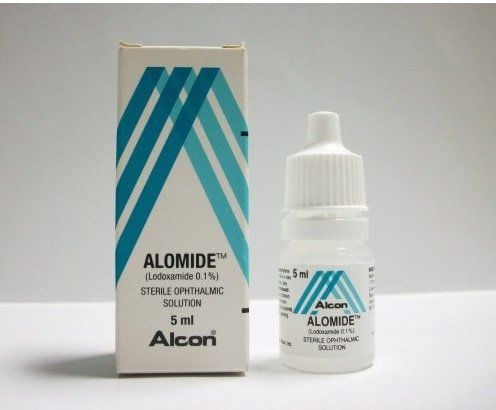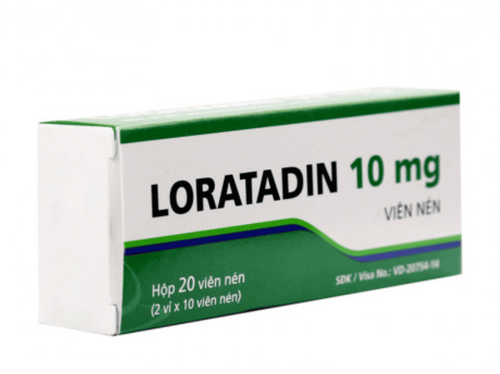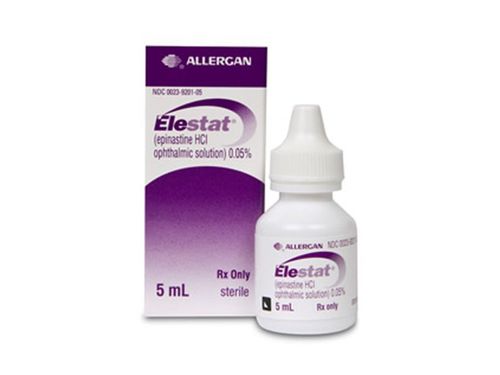This is an automatically translated article.
Relestat medicine contains the active ingredient Epinastine HCl 0.05% equivalent to Epinastine 0.044%. The drug belongs to the group of drugs used in ophthalmology, decongestants and antiallergic drugs. So what is Relestat and how does it work?
1. What does Relestat do?
Relestat is indicated for the treatment and prevention of itchy eyes associated with allergic conjunctivitis in adolescent and adult patients.
Pharmacodynamic properties:
Epinastine is an inhibitor of histamine release from mast cells and a direct H1-receptor antagonist. Epinastine has selective activity for histamine H1 receptors and has affinity for histamine H2 receptors. Epinastine is unlikely to cause CNS side effects because it cannot cross the blood-brain barrier. Pharmacokinetic properties:
According to the study, in 14 patients with allergic conjunctivitis using Relestat at the dose: 1 drop of ophthalmic solution in each eye, 2 times a day continuously for 7 days. On day 7, the mean maximum Epinastine plasma concentration reached after approximately 2 hours was 0.04 ± 0.014 ng/ml indicating low systemic exposure. Epinastine is approximately 64% bound to plasma proteins. The total systemic clearance is about 56 l/h and the plasma half-life is about 12 hours. Epinastine is eliminated mainly unchanged. Approximately 55% of an intravenous dose was recovered unchanged in the urine and about 30% in the faeces. Less than 10% of epinastine is metabolized and eliminated by the kidneys mainly through active tubular secretion.
2. Dosage and how to use Relestat
Relestat is indicated for use by eye drops. Recommended dosage: Instill 1 drop in each eye, 2 times a day.
Note:
Relestat can be used to treat adolescent patients 12 years of age and older at the same dose indicated for adults. The drug should be used continuously throughout the exposure period, even in the absence of symptoms, to avoid recurrence of the disease. There is no experience in clinical studies with use longer than 8 weeks. If the patient is using another type of eye drops, they should be used at least 10 minutes apart. Depending on the condition and the progression of the disease, there may be different doses of drugs. It is necessary to consult a doctor or medical professional for an appropriate dose, do not self-medicate. If you miss a dose, take it as soon as possible. If it is almost time for your next dose, skip the missed dose and take the next dose as directed. Do not take double the prescribed dose. Following instillation of Epinastine HCL 0.3% ophthalmic solution 3 times/day (more than 9 times the recommended daily dose), reversible miosis was observed without affecting visual acuity or other ocular parameters. After using the drug, users who see any unusual symptoms should immediately report to a qualified doctor or pharmacist to diagnose the condition and have timely treatment methods.
3. Side effects of the drug Relestat
When using Relestat, in addition to the main effects of the drug, users may experience some unwanted symptoms. In clinical studies with Epinastine HCL 0.05% ophthalmic solution, most adverse reactions were ocular and were mild and not serious.
Some common symptoms: Eye disorders appear burning sensation, eye irritation Some uncommon symptoms: Headache, conjunctival congestion, itchy eyes, visual disturbances, rhinitis Note: When If you experience any side effects of the above-mentioned drugs or any unusual symptoms, you should stop using the medicine and notify your doctor or go to the nearest medical facility for timely treatment.
4. Relestat drug interactions
No drug interaction studies with Relestat have been performed. No interaction with other drugs is expected in humans because systemic exposure to Epinastine is very low after ophthalmic administration. Furthermore, Epinastine is mainly eliminated unchanged showing minimal metabolism.
However, patients should fully list functional foods such as vitamins, minerals and drugs they are taking so that doctors and pharmacists can prescribe them appropriately, avoiding drug interactions that are not beneficial to the user.
5. Some notes when using Relestat
Patients treated for eye irritation caused by contact lenses should not use this medicine. The preservative Benzalkonium Chloride in the medicine can be absorbed by soft contact lenses. Therefore, the patient should remove the contact lens from the eye before instilling the drug and wait 10-15 minutes for the solution to penetrate and then can put the contact lens back on. Avoid direct contact with the tip of the vial to the eye, the periorbital area, or any other surface to prevent common bacteria from contaminating the solution that can cause an eye infection. The ophthalmic safety of Epinastine ophthalmic solution has been tested in 96 pediatric subjects aged 3 to 12 years, and it has been shown to be safe and well tolerated. However, there are no adequate studies on the effects of Relestat in children under 3 years of age, so it should be used with caution in this population. The drug has not been studied in patients with a life expectancy greater than 65 years. Care should be taken when using this drug for this subject. If you are driving or using machinery, if you experience transient blurred vision while instilling the medication, you should wait until your vision clears before you resume work. Relestat eye drops should be used during pregnancy only if clearly needed. A study in rats detected the excretion of Epinastine in the milk of the mother. It is not known whether this drug is excreted in human milk. Therefore, caution should be exercised when Relestat eye drops are administered to a nursing woman. Above is all information about the drug Relestat, patients need to carefully read the instructions for use, consult a doctor / pharmacist before using. Note, this is a prescription drug, the patient needs to use the drug as prescribed by the doctor, absolutely do not self-treat at home.













